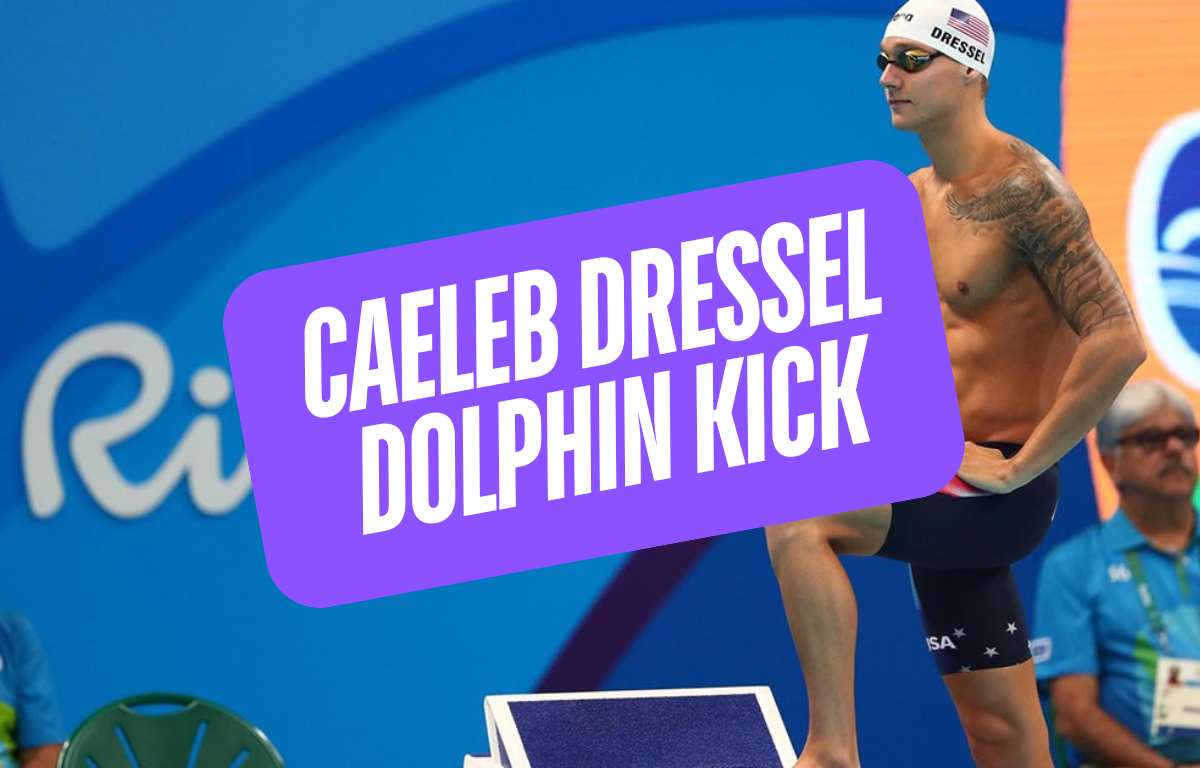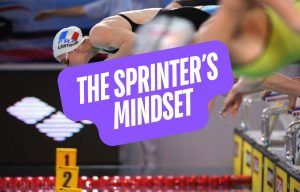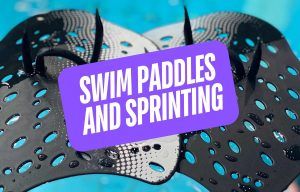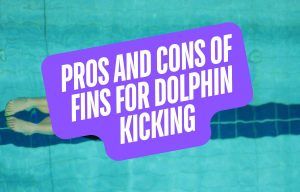Looking to upgrade your dolphin kick? Here’s what you can learn from Caeleb Dressel, one of the best to do it.
Caeleb Dressel’s underwater dolphin kick sidesteps a lot of the prevailing wisdom about what a “perfect” dolphin kick should look like.
He uses an undulatory style that replicates the same movement patterns as fish kicking, he doesn’t kick right away when he enters the water, and he dolphin kicks all the way into his first stroke cycle when swimming freestyle.
Dressel’s explosiveness has always been obvious, but it’s the details of his dolphin kick that provide a lot of takeaways and practical insights for swimmers and coaches looking to master the fifth stroke.
Here’s a look at Caeleb Dressel’s underwater dolphin kick and what swimmers can learn from one of the best to ever do it.
Dolphin Kick Like Caeleb Dressel
- Ride the glide
- Use powerful tempo
- Longer body wave
- Fast toe velocity
- Power > Drag
- Dolphin kick breakout
- Work on technique
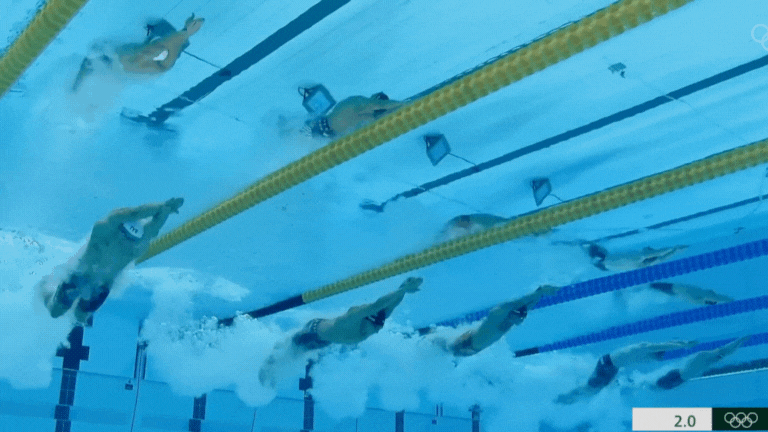
Ride the Glide
Dressel’s explosive start is legendary. He launches himself off of the blocks, swings the arms around the side, and flies halfway across the pool before entering the water. He leverages this explosiveness perfectly when entering the water and not kickingright away.
As Dressel enters the water, he pauses for a small beat before dolphin kicking. This maximizes the velocity from his start. A short glide reduces needless deceleration, extends the length of the breakout, and avoids wasting energy fighting added drag.
Most swimmers start dolphin kicking way too early after the dive. One study with national-level swimmers (Elipot et al., 2010) showed that swimmers started kicking an average of 1.69m too soon. These swimmers also surfaced sooner and used a steeper trajectory in the breakout, which reduced their breakout speed.

When you’re full of adrenaline and nerves, it can be challenging to pause that tiny moment when diving into the water, but it can pay off in more speed.
Powerful Tempo
Dressel uses a relatively controlled tempo. It’s fast, yes, but it’s not the fastest in the pool. Dolphin kick tempo varies widely by swimmer and depends on your specific biomechanics, event choice, and conditioning.
One only has to look at swimmers like Maggie Mac Neill and Gretchen Walsh. Both are absolutely world-class dolphin kickers with vastly different amplitudes and frequencies. A study by Connaboy et al., (2016) also showed that different movement strategies can be equally effective for fast dolphin kicking, whether it’s a wider amplitude and slower tempo, or a narrower kick with a high frequency.
See also: 3 Things Swimmers Can Learn from Gretchen Walsh’s Underwater Dolphin Kick
In the Tokyo Olympics 50m freestyle final, Dressel’s tempo was about 2.27 Hz (0.44 seconds per kick):
- First kick: 1.9s
- Last kick: 4.1s
- # of kicks: 6
- Kick tempo: 2.27 Hz (0.44s per kick)
Tempo is a tool for controlling vortex generation. A hyper-fast tempo can cause vortices to shed before they’ve fully formed. A slightly slower tempo can actually increase speed by helping swimmers develop larger, more stable vortices that behave like industrial-grade whirlpools, shooting us through the water with more thrust.
Dressel’s “slower” tempo is purposeful—he sculpts large, powerful vortices that he then uses for incredible levels of propulsion.
Longer Body Wave
Dressel initiates the dolphin kick higher in his trunk compared to other proficient dolphin kickers. This increases the velocity of the body wave (a way to measure undulation speed) and creates a more explosive foot action, displacing more water for increased propulsion.
Most swimmers kick from the torso and hips. Which is a good start and is obviously better than kicking from the knees.
But high-level swimmers like Dressel and Jordan Crooks begin the kick in the upper trunk, generating a longer and more forceful undulatory motion.
He is creating a longer body wave, a bigger whip, and more velocity where it matters most—in the feet at the end of the kick, where a majority of the propulsion happens.
Fast Toe Velocity
Dressel’s toe velocity in his dolphin kick is smooth and very fast. Toe velocity—a measurement of how quickly the toes/feet go up and down in the kick cycle—is one of the most commonly cited characteristics of an elite dolphin kick (Atkinson et al., 2014).
Dressel’s toe speed is lightning-quick when you consider the amount of distance his feet are traveling. He is using large kicks and moving the feet quickly and aggressively in both directions.
Swimmers looking to improve their toe velocity should pay special attention to improving their upkick, which many use as a passive/recovery phase instead of an active one.
Power > Drag
Swimming fast is a series of trade-offs. In Dressel’s underwater dolphin kick, he willingly accepts the extra vertical movement in the shoulders and upper trunk, which increases frontal drag, in exchange for the added power that motion generates.
Dressel’s style defies some of the classic dolphin kick “rules”: that the upper body should remain still. Instead, his shoulders and upper trunk create significant vertical motion.
See also: 5 Dryland Exercises for Faster Underwater Dolphin Kicking
But he is so powerful and controls the undulation so well that the combination of power and elongated vortex generation overcomes the drag forces that would stop other swimmers in their tracks.
Dolphin kicks into the first stroke
Dressel uses a butterfly breakout when swimming freestyle. By this I mean he takes one large, final dolphin kick into his first stroke cycle, with no freestyle kick transition to the surface. He is still dolphin kicking when the first arm pull begins and he is at the surface.
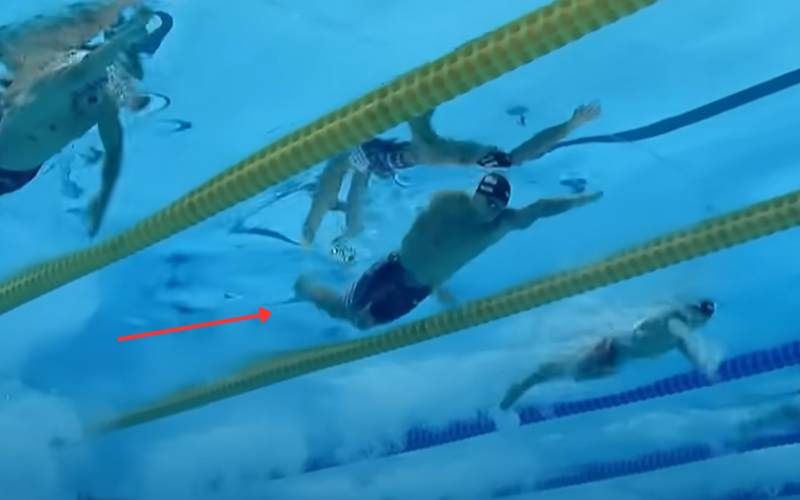
Being a butterflyer, this type of transition would feel second-nature to him. Butterflyers to have the shortest and quickest transition from dolphin kicking à first stroke of the three strokes that use dolphin kicks in the breakout.
(Michael Phelps used the same type of underwater dolphin kick breakout when swimming freestyle.)
There are lots of benefits to this breakout technique for swimmers who can make the timing and coordination work, including more power in that first stroke and the benefits of increased velocity (dolphin kicking underwater is significantly faster than freestyle kicking).
Technical focus
Dressel is well-known for his analytical nature. Through the years of training at Bolles, and then at Florida, he kept detailed logbooks where he analyzed and tracked his swim training. So it’s no accident that he was highly analytical about developing smooth, powerful dolphin kicking as an age grouper.
Jason Calanog, his age group coach at Bolles, told me how Dressel would focus relentlessly on improving kick technique in practice, devoting countless laps and reps to fine-tuning his dolphin kick.
“He’s been working on it for years, with slow, perfect kicks in practice,” said Calanog.
In other words, Dressel’s excellent dolphin kick technique wasn’t an accident or a fluke.
It was worked on relentlessly in training.
The Bottom Line
Caeleb Dressel’s underwaters are a master class in maximizing your skills and unique strengths. He shows that devastating, gold-medal winning speeds under the surface are a blend of power, timing, and technique.
And that what matters most is kicking in a way that leverages your abilities, biomechanics, event choice, and conditioning.
Dolphin kick technique can feel impossible or overwhelming at times, given the complexity of the movement paired with the muscular and respiratory challenges that come along with it.
But while few of us will ever kick as fast as Dressel, a first-ballot Hall of Fame underwater dolphin kicker, we can learn from what propelled him to fifth stroke glory.
Happy kicking!
The Ultimate Guide to a Faster Underwater Dolphin Kick
Want help leveling up your underwater dolphin kick? The Dolphin Kick Manual is the ultimate resource for helping swimmers and swim coaches develop a world-class underwater dolphin kick.

The Dolphin Kick Manual is a beastly 240+ pages of actionable insights and research into elite dolphin kicking technique and performance. It details everything from mastering undulation to vortex recapturing to structuring a dryland program for dolphin kicking success.
It combines evidence-based insights with a collection of 20 ready-to-go sets and a 6-week Action Plan to help swimmers set a course for dolphin kicking success.
Train smarter and kick faster.

